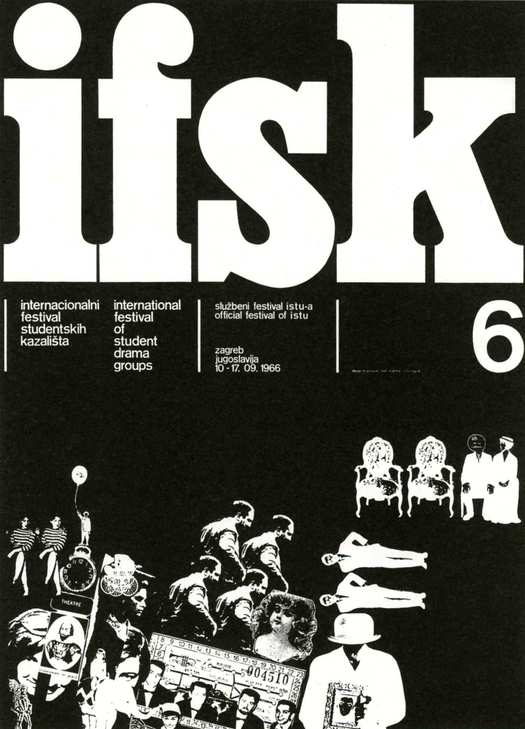
Mihajlo Arsovski, poster for 6th International Festival of Student Drama Groups (IFSK), 1966
In one of my earliest posts for Design Observer, following a trip to Slovenia, I wrote about how little designers in English-speaking countries know about the growth of graphic design and visual culture in central and eastern Europe after the Second World War. English-language graphic design history surveys tend to stop at Polish posters, which have long been known in the west, and when local design historians write histories, it’s rare for them to be translated into English.
Last year, during a visit to Zagreb, the Croatian capital, a colleague and friend, Dejan Kršić, showed me the catalogue, with Croatian text, for a big exhibition I had just missed at the city’s Museum of Contemporary Art, titled “Socialism and Modernity: Art, Culture, Politics, 1950-1974,” with sections on the modernization of the Yugoslavian state, architecture, art, visual communication, and socialist popular culture. Kršić — author of a monograph about Mirko Ilić — wrote the chapter about graphic design and the examples he revealed to me opened another window on this engagingly unfamiliar history.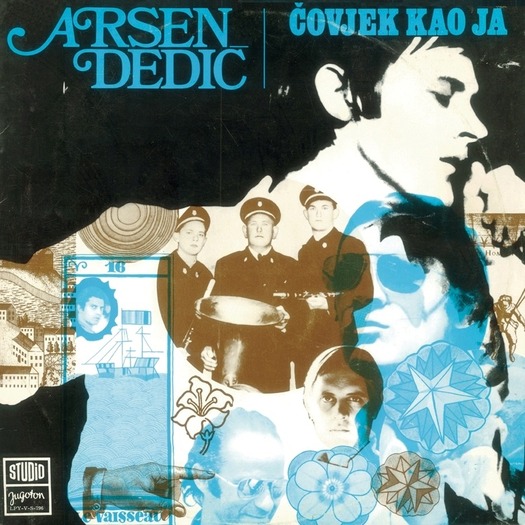
Mihajlo Arsovski, album cover of Arsen Dedić's “A Man Like Me,” Jugoton, 1969
The book is now available in an English translation, though at this stage it can only be obtained from a Croatian site; it really needs to be on Amazon. Kršić is an art historian by training and he works as a writer, editor, publisher and translator, in addition to his activities as a designer. He also collaborates with the highly regarded Croatian curatorial team What, How and for Whom (WHW). If he were based in New York or London, he would be celebrated widely as a notable figure. His chapter is a thoroughly researched, detailed and important contribution to the wider understanding of graphic design in the former Socialist Federal Republic of Yugoslavia (which lasted until the country’s break-up in 1991). It’s also a slightly mournful tale in which the optimism of post-war design pioneers committed to design as an agent of social planning, and to the humanization of the working and living environment, eventually loses out to the imperatives of the market and the bureaucratic logic of growth. Perhaps that outcome sounds all too familiar?
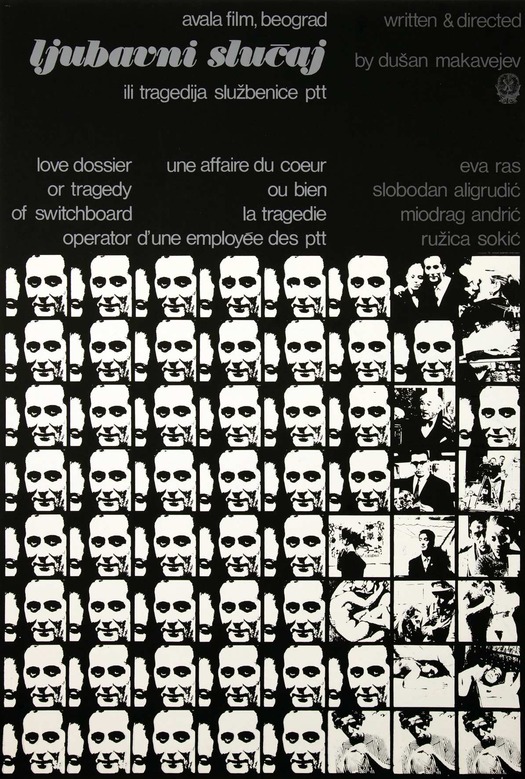
Mihajlo Arsovski, film poster for Love Dossier, or the Tragedy of the Switchboard Operator, 1966
Here, to give the flavor, I’m showing several pieces of work from the 1960s and early 1970s by Mihajlo Arsovski, just one of several excellent designers featured in Kršić’s chapter. Arsovski wasn’t completely unknown to me; we showed a few largely typographical pieces in Eye way back in an overview of Croatian design. Only the intro to that article is available and I can find nothing substantial about him in English online. In 2011, a book about Arsovski was published in Croatia but, irritatingly, that isn’t sold by Amazon either, and I don’t have a copy. Kršić is working on a monograph of his own and he showed me some of his extensive collection of pieces by the designer. Arsovski’s work from this period combines pop culture references (see the wry Mothers of Invention album cover quotations in the Pop Express poster below) and a collage style with carefully composed structures in which everything locks together tightly; the typography has an exhilarating sense of playfulness, like a pictorial element in its own right, as well as visual drama.
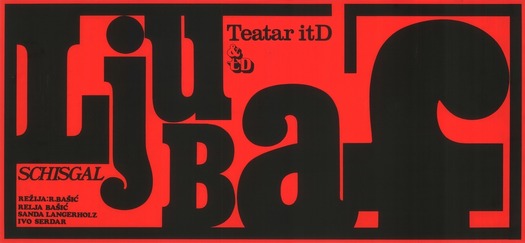
Mihaljo Arsovski, poster for the play “Luv,” Theater &TD, Zagreb, 1966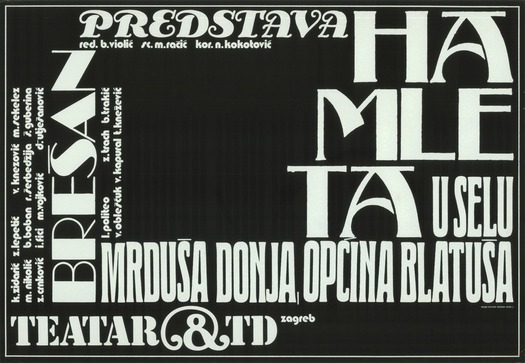
Mihajlo Arsovski, poster for the play “Acting Hamlet in the Village of Mrduša Donja,” Theater &TD, Zagreb, 1971
“This was phase two of the high-modernist period, considered late-modernist or even mannerist by some authors,” writes Kršić. “However, our view is that his work from that period — given the choice of typefaces and the manner of using typography, collage processes and, in contemporary words, sampling motifs by combining elements of high and popular culture — can best be described as postmodernism in a time that was not yet familiar with the term.” That means that Arsovski, by 1966, despite the differences of culture and context, was engaged in a pre-postmodernist questioning of modernism much like that seen at Glaser and Chwast’s Push Pin Studios, or in the “Carnaby Street” pop graphics of “swinging” 1960s London.
Surely, I thought, someone this good must have been recognized at the time by the Alliance Graphique Internationale, despite the awkward political barriers. There were Polish, Czech and East German AGI members in the 1960s, after all. Sadly not, it seems. It’s hardly news that we need to trample over the boundaries of conventional historical accounts in search of other graphic histories. Here is another fine example of what we might have been missing all those years.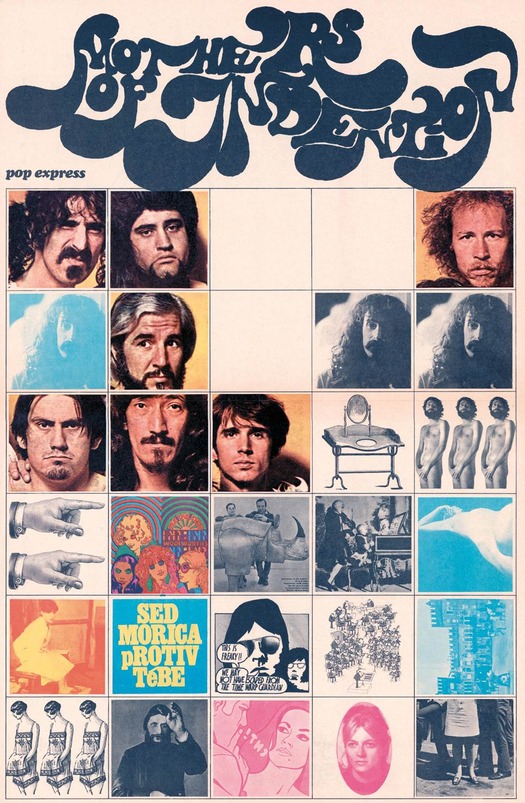
Mihajlo Arsovski, centerfold poster for Pop Express no. 9, 1969
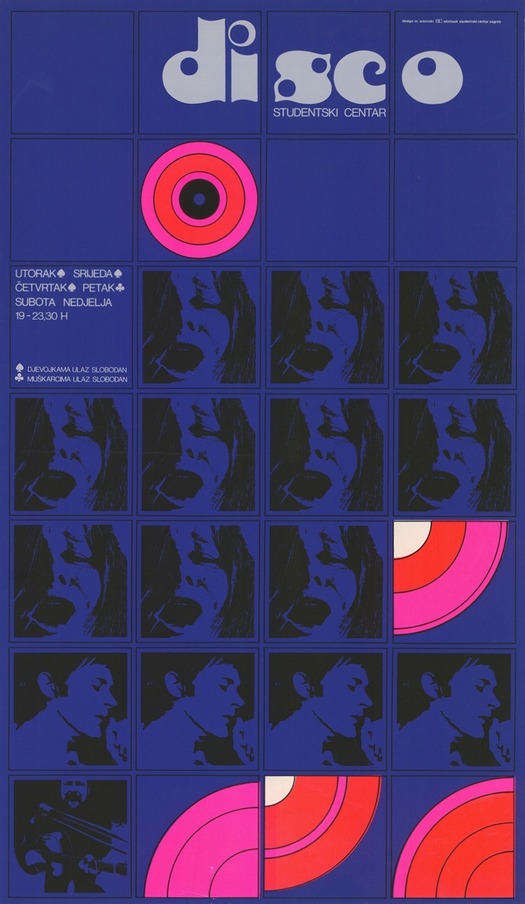
Mihajlo Arsovski, disco poster for the Students' Center, Zagreb, 1969/70 (not in book)
See also:
In Praise of the East European Film Poster
Starowieyski’s Graphic Universe of Excess

